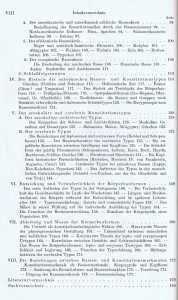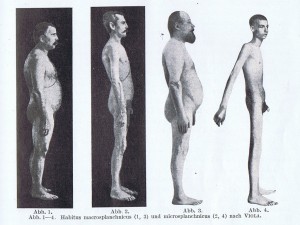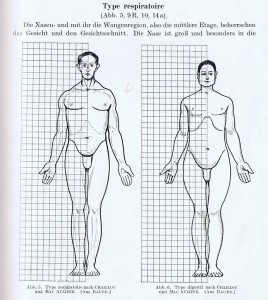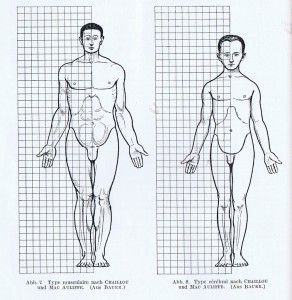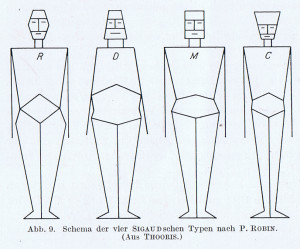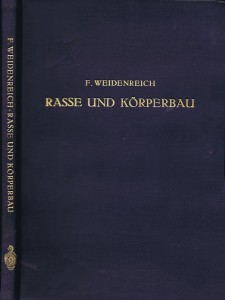
Author: Weidenreich, Franz
Edition Cited in The Compleat Witch
Publisher: Springer
City: Berlin
Year: 1926
additional information
Pages: 187
Binding: Hardback
Size: 6.75 x 9.75
Binding: Hardback
Size: 6.75 x 9.75
Back Cover Copy
(N/A)
Online Resources
OpenLibrary
Archive.org
Google Books
Project Gutenberg
Wikipedia (author)
WorldCat
LibraryThing
GoodReads
Editions
(arranged by year)
(arranged by year)
Title: (if different)
Subtitle: (if different)
Year:
Subtitle: (if different)
Year:
Publisher:
Pages:
Binding: (hardback, paperback, booklet, other)
Size: (width x height in inches)
Pages:
Binding: (hardback, paperback, booklet, other)
Size: (width x height in inches)
Cover Price:
ISBN:
LoC:
ISBN:
LoC:
Notes: (revised, foreword by, afterword by, etc.)
Reviews
(from American Anthropologist, 1928)
Rasse und Korperbau.
FRANZ WEIDENREICH. Berlin: Julius Springer, 1927. 187 pp., 201 ills.
The concept of bodily constitutional types goes back to the Greeks and has had its principal recognition in the field of medicine. Of late it has been developed in connection with psychiatry and certain lines of inexact or popular psychology. In the most recent years constitutional types have begun to be taken cognizance of by physical anthropologists, partly under the influence of sister disciplines, partly, it may be suspected, as a relief from the relative sterility into which the study of races has got itself. The concept of type obviously cross-cuts that of race, and therefore holds out a promise of new results. Weidenreich’s monograph opens with the sentence: “This book is of strictly scientific nature.” It therefore deserves serious consideration, in itself and as a symptom of trend. Two principal constitutional types are recognized, the Leptosome and Eurysome: one narrow, long, slender, delicate, the other broad, short, thickset, heavy, and rugged. Essentially Leptosome and Euroysome traits respectively characterize the Phthisic and Carcinomatous types of Beneke, the Asthenic and Apoplectic of Stiller, the Microsplanchnic and Macrosplanchnic of Viola, the Respiratory and Digestive of Sigaud, Chaillou, and MacAuliffe, the Hyperontomorph and Mesoontomorph of Bean, the Asthenic and Pyknic of Kretschmer, the Lineal and Lateral of Stockard, the Leptoprosopic and Chamaeprosopic of Kollmann. Weidenreich shows that these two types appear in both sexes and in all races. They are the fine or Choshui and the coarse or Satsuma type in the Japanese; the Aryan or Assyroid and the Negritoid elements among the Chinese according to Legendre or Mongolian and Malayan according to Hagen; the narrow and broad-nosed Papuans; the Hamitic and Asiatic strains in Egypt; the pure Nordic and Cro-Magnon in northern Europe; the Sephardic and Ashkenaz among the Jews. In virtually every case the attempt has been made by the determiners of these types to derive them from separate ethnic, that is, racial, origins. Although such theories have had little support from conservative anthropologists, they have enjoyed some vogue, and Weidenreich’s analysis will be welcome for definitely eliminating these speculations. He shows that individuals of corresponding types occur among Negroes, American Indians, Polynesians, Australians, Veddas, and probably every population. Sigaud’s Muscular and Kretschmer’s Athletic type are disposed of as functional variations of normal types. The Cerebral type is valid to the extent of being a characteristic cephalic variant of both Leptosome and Eurysome. It is associated with brachycephaly. So far as the data go, there have been no true dolichocephals among the greatest German intellects. The Leptosome and Eurysome types are traceable in fossil man, in the Primates, and in domestic animals. (Wheeler has recently shown them in insects.) They represent extremes of form of growth, porbably more or less hereditary; the causes of the origin of the types are obscure: Type and race traits per se are not distinguishable; it is the combination of traits, and their prevalent recurrence within a population, that makes them racially significant. Weidenreich thoroughly keeps the promise of his first sentence. The subject of types will probably be considerably exploited in the next few years. His work shows that it can be treated without recourse to half-evidence, loose definition, or fantasy.
A. L. KROEBER
Additional Photos/Images
(Sample Illustrations, Cited Edition)
Misc. Quotes
(Interesting or pithy quotes from the book)
Disclaimer
Due to the obscurity of some titles, the contents of The Compleat Witch Illustrated Bibliography Project may contain information that is inaccurate or incomplete. We encourage readers to submit corrections and pertinent addenda like images, quotes, or other information, either as a Comment on the appropriate post or via The Compleat Witch Illustrated Bibliography Facebook page.

